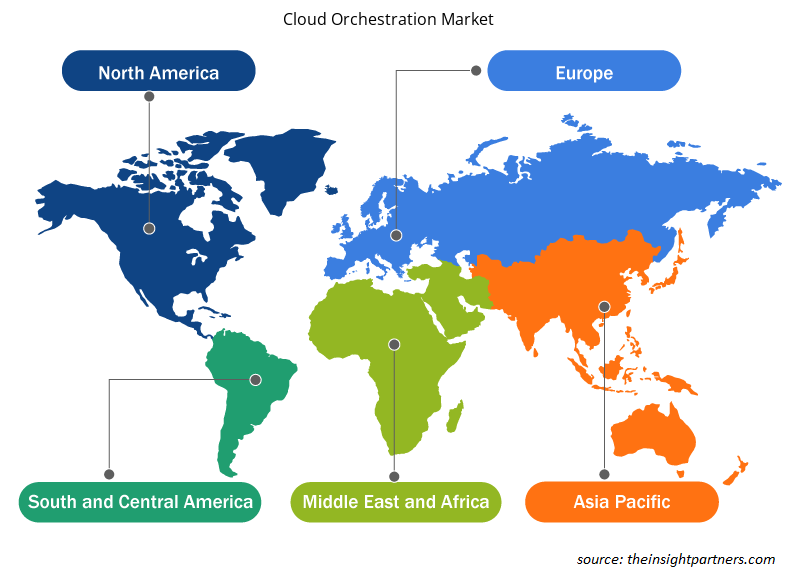クラウド オーケストレーション市場は、2023 年から 2031 年にかけて 18.6% の CAGR を記録し、市場規模は 2023 年の XX 百万米ドルから 2031 年には XX 百万米ドルに拡大すると予想されています。
レポートは、サービス(レポートと分析、クラウドサービスの自動化、サポートとメンテナンス、トレーニングとコンサルティング、統合)、展開(パブリッククラウド、ハイブリッドクラウド、プライベートクラウド)、アプリケーション(自動スケーリング、コンプライアンス監査、プロビジョニング、その他)、企業規模(中小企業と大企業)、業界(BFSI、教育、製造、政府、メディアとエンターテイメント、ITと通信、その他)別にセグメント化されています。グローバル分析は、地域レベルと主要国でさらに細分化されています。レポートでは、上記の分析とセグメントの値をUSDで提供しています。
報告書の目的
The Insight Partners のレポート「クラウド オーケストレーション市場」は、現在の状況と将来の成長、主な推進要因、課題、機会を説明することを目的としています。これにより、次のようなさまざまなビジネス関係者に洞察が提供されます。
- テクノロジープロバイダー/メーカー: 進化する市場の動向を理解し、潜在的な成長機会を把握することで、情報に基づいた戦略的意思決定が可能になります。
- 投資家: 市場の成長率、市場の財務予測、バリュー チェーン全体に存在する機会に関する包括的な傾向分析を実施します。
- 規制機関: 市場の濫用を最小限に抑え、投資家の信用と信頼を維持し、市場の完全性と安定性を維持することを目的として、市場における政策と警察活動を規制します。
クラウドオーケストレーション市場のセグメンテーション
サービス
- レポートと分析
- クラウドサービスの自動化
- サポートとメンテナンス
- トレーニングとコンサルティング
- 統合
展開
- パブリッククラウド
- ハイブリッドクラウド
- プライベートクラウド
応用
- 自動スケーリング
- コンプライアンス監査
- プロビジョニング
- その他
企業規模
- 中小企業と大企業
企業規模
- 中小企業と大企業
要件に合わせてレポートをカスタマイズする
このレポートの一部、国レベルの分析、Excelデータパックなど、あらゆるレポートを無料でカスタマイズできます。また、スタートアップや大学向けのお得なオファーや割引もご利用いただけます。
-
このレポートの主要な市場動向を入手してください。この無料サンプルには、市場動向から見積もりや予測に至るまでのデータ分析が含まれます。
クラウドオーケストレーション市場の成長要因
- マルチクラウド環境の複雑さ: 組織がマルチクラウドやハイブリッド クラウド戦略を採用するケースが増えるにつれ、異なるクラウド環境の管理はより複雑になります。クラウド オーケストレーション プラットフォームは、さまざまなクラウド プロバイダー間でのワークロード、リソース、サービスの管理を合理化および自動化し、統合を簡素化して運用効率を高めます。この複雑さの増大により、シームレスなクラウド運用を保証するオーケストレーション ソリューションの需要が高まっています。
- 運用効率と自動化の必要性: 組織は、日常的なタスクを自動化し、効率を高め、手動介入を減らすために、クラウド オーケストレーションを採用するケースが増えています。クラウド オーケストレーションを使用すると、企業はプロビジョニング、スケーリング、監視、構成管理を自動化し、これらのタスクに費やす時間と労力を削減できます。これによりコストが削減され、生産性が向上するため、オーケストレーション ソリューションは現代の IT インフラストラクチャに不可欠なものとなっています。
クラウドオーケストレーション市場の将来動向
- サーバーレス コンピューティングの台頭: サーバーレス コンピューティングはクラウド オーケストレーション市場で注目を集めており、開発者はインフラストラクチャ管理を気にすることなくコードの作成に集中できます。クラウド オーケストレーション プラットフォームはサーバーレス アーキテクチャをサポートするように進化しており、組織は手動でサーバーを管理せずにアプリケーションやサービスを実行できます。この傾向により、クラウド リソース管理がさらに簡素化され、スケーラビリティが向上します。
- DevOps と継続的インテグレーション/継続的デリバリー (CI/CD) の統合: クラウド オーケストレーション プラットフォームは、DevOps および CI/CD パイプラインとますます統合され、ソフトウェア開発とデプロイメントのための自動化されたシームレスなワークフローを実現しています。この統合により、開発チームと運用チーム間のコラボレーションが強化され、ソフトウェア配信が加速され、品質管理が改善されるため、オーケストレーションは現代の DevOps プラクティスの重要な部分になります。
クラウドオーケストレーションの市場機会
- クラウドネイティブ アプリケーション管理: クラウドネイティブ アプリケーションの採用が拡大しており、これらのアプリケーションを効率的に管理するには、堅牢なオーケストレーション ソリューションが必要です。マイクロサービスとコンテナの自動展開、スケーリング、管理のためのツールを提供することで、クラウド オーケストレーション プラットフォームは、クラウドネイティブ環境に移行する企業にとって不可欠な存在となり、新たな成長の道を切り開きます。
- 業界固有のオーケストレーション ソリューション: 医療、金融、小売などの分野に合わせて、業界固有のクラウド オーケストレーション ソリューションを開発する機会があります。これらの業界には、カスタマイズされたオーケストレーション機能を必要とする独自の規制、データ セキュリティ、運用上のニーズがあります。これらの業界固有の要件に対処することで、プロバイダーはニッチなソリューションを作成し、競争の激しい市場で差別化を図ることができます。
クラウド オーケストレーション市場の地域別分析
予測期間を通じてクラウド オーケストレーション市場に影響を与える地域的な傾向と要因は、Insight Partners のアナリストによって徹底的に説明されています。このセクションでは、北米、ヨーロッパ、アジア太平洋、中東およびアフリカ、南米および中米にわたるクラウド オーケストレーション市場のセグメントと地理についても説明します。

- クラウドオーケストレーション市場の地域別データを入手
クラウドオーケストレーション市場レポートの範囲
| レポート属性 | 詳細 |
|---|---|
| 2023年の市場規模 | XX百万米ドル |
| 2031年までの市場規模 | XX百万米ドル |
| 世界のCAGR(2023年~2031年) | 18.6% |
| 履歴データ | 2021-2022 |
| 予測期間 | 2024-2031 |
| 対象セグメント |
サービス別
|
| 対象地域と国 |
北米
|
| 市場リーダーと主要企業プロフィール |
|
クラウド オーケストレーション市場のプレーヤー密度: ビジネス ダイナミクスへの影響を理解する
クラウド オーケストレーション市場は、消費者の嗜好の変化、技術の進歩、製品の利点に対する認識の高まりなどの要因により、エンド ユーザーの需要が高まり、急速に成長しています。需要が高まるにつれて、企業は提供内容を拡大し、消費者のニーズを満たすために革新を起こし、新たなトレンドを活用し、市場の成長をさらに促進しています。
市場プレーヤー密度とは、特定の市場または業界内で活動している企業または会社の分布を指します。これは、特定の市場スペースに、その市場規模または総市場価値に対してどれだけの競合相手 (市場プレーヤー) が存在するかを示します。
クラウド オーケストレーション市場で事業を展開している主要企業は次のとおりです。
- モーフィアスデータLLC
- BMCソフトウェア株式会社
- クラウドボルトソフトウェア株式会社
- Cloudify Platform株式会社
- エンボティクス株式会社
- IBM
免責事項:上記の企業は、特定の順序でランク付けされていません。

- クラウドオーケストレーション市場のトップキープレーヤーの概要を入手
主なセールスポイント
- 包括的なカバレッジ: レポートでは、クラウド オーケストレーション市場の製品、サービス、タイプ、エンド ユーザーの分析を包括的にカバーし、全体的な概要を提供します。
- 専門家による分析: レポートは、業界の専門家とアナリストの深い理解に基づいてまとめられています。
- 最新情報: このレポートは、最新の情報とデータの傾向を網羅しているため、ビジネスの関連性を保証します。
- カスタマイズ オプション: このレポートは、特定のクライアント要件に対応し、ビジネス戦略に適切に適合するようにカスタマイズできます。
したがって、クラウド オーケストレーション市場に関する調査レポートは、業界のシナリオと成長の見通しを解読して理解する道の先導役となる可能性があります。正当な懸念事項がいくつかあるかもしれませんが、このレポートの全体的な利点は欠点を上回る傾向があります。
- 過去2年間の分析、基準年、CAGRによる予測(7年間)
- PEST分析とSWOT分析
- 市場規模価値/数量 - 世界、地域、国
- 業界と競争環境
- Excel データセット
最新レポート
お客様の声
購入理由
- 情報に基づいた意思決定
- 市場動向の理解
- 競合分析
- 顧客インサイト
- 市場予測
- リスク軽減
- 戦略計画
- 投資の正当性
- 新興市場の特定
- マーケティング戦略の強化
- 業務効率の向上
- 規制動向への対応























 無料サンプルを入手 - クラウドオーケストレーション市場
無料サンプルを入手 - クラウドオーケストレーション市場